507. Possibly the Tau (Τ)
sign - as in for instance Tau-ono (the
Pleiades) - illustrated a pair of stones, a
horizontal 'square slab' on top of a great vertical upright.
And
possibly the idea was to convey the sense of pushing
up. In which case Tau-ono might mean not 6 (ono)
stones but 6 double-stones (doubly good).
... In Hindu legend there was a mother goddess
called Aditi, who had seven offspring. She is
called 'Mother of the Gods'. Aditi, whose
name means 'free, unbounded, infinity' was assigned
in the ancient lists of constellations as the regent
of the asterism Punarvasu. Punarvasu
is dual in form and means 'The Doublegood Pair'. The
singular form of this noun is used to refer to the
star Pollux. It is not difficult to surmise that the
other member of the Doublegood Pair was Castor. Then
the constellation Punarvasu is quite
equivalent to our Gemini, the Twins. In far
antiquity (5800 BC) the spring equinoctial point was
predicted by the heliacal rising of the Twins
...
|
Tauono.
'Six stones'
= Pleiades =
Matariki. Van
Tilburg. |
|
Tautoru.
The Belt of
Orion. Van Tilburg. Mgv.: 1.
Toutoru,
Orion's belt. Mq.:
tautou, a
constellation of three
stars. 2.
Toutoru. hung
by threes. Mq.:
tautou, id.
Churchill. |
|
Toko.
Tokotoko,
stick, cane, crutches, axe
helve, roller, pole, staff.
P Pau.:
tokotoko,
walking stick. Mgv.:
toko,
a pole, stilts, staff. Mq.:
tokotoko,
toótoó,
stick, cane, staff. Ta.:
too,
id. Churchill.
The
higher-ranked of the two
largest political units on
Rapa Nui was the
Ko Tu'u Aro Ko Te Mata Nui.
This literally translates as
The Mast/Pillar/Post
[standing] Before the
Greater Tribes.
Toko te rangi,
or Sky Propper, is named by
Métraux in his corrected
Miru genealogy as the
thirteenth king of Easter
Island and as one of the
lineages or subgroups of the
Miru. Although we
have no record of the Sky
Propper legend on Rapa
Nui, other Polynesian
legends of the Sky Propper
are widely known, and they
are formative elements in
the basic cosmogenic theory
of Polynesian belief.
Sky (rangi)
and Earth (papa) lay
in primal embrace, and in
the cramped, dark space
between them procreated and
gave birth to the gods such
as Tane, Rongo
and Tu. Just as
children fought sleep in the
stifling darkness of a
hare paenga, the gods
grew restless between their
parents and longed for light
and air. The herculean
achievement of forcing Sky
to separate from Earth was
variously performed by
Tane in New Zealand and
the Society Islands, by
Tonofiti in the
Marquesas and by Ru (Tu)
in Cook Islands. After the
sky was raised high above
the earth, props or poles
were erected between them
and light entered,
dispelling the darkness and
bringing renewed life. One
detail which is
iconographically of interest
is whether the god
responsible for separating
Earth and Sky did so by
raising the Sky with his
upraised arms and hands, as
in Tahiti and elsewhere, or
with his feet as in New
Zealand.
The actual
props, pillars or posts
which separated the sky and
earth are called toko
in New Zealand, to'o
in the Marquesas Islands and
pou in Tahiti. In
Rapanui tuu and
pou are known, with
pou meaning column,
pillar or post of either
stone or wood. Sometimes the
word is applied to a natural
rock formation with postlike
qualities which serves as an
orientation point. The star
Sirius is called Te Pou
in Rapanui and
functions in the same
way. One monolithic basalt
statue is called Pou
Hakanononga, a somewhat
obscure and probably late
name thought to mean that
the statue served to mark an
offshore tuna fishing site.
The Rapanui word
tokotoko means pole or
staff. Sacred ceremonial
staves, such as the ua
on Rapa Nui, were
called toko in
Polynesia. Based upon the
fact that toko in New
Zealand also means 'rays of
light', it has been
suggested that the original
props which separated and
held apart Sky and Earth
were conceived of as shafts
of dawn sunlight. In most
Polynesian languages the
human and animate classifier
is toko-, suggesting
a congruence of semantic and
symbolic meaning between
anthropomorphic form and
pole or post. Tane as
First Man and the embodiment
of sunlight thus becomes, in
the form of a carved human
male figure, the probable
inspiration for the moai
as sacred prop between Sky
and Earth. The moai
as Sky Propper would have
elevated Sky and held it
separate from Earth,
balancing it only upon his
sacred head. This action
allowed the light to enter
the world and made the land
fertile. Increasing the
height of the statues, as
the Rapa Nui clearly
did over time, would
symbolically increase the
space between Sky and Earth,
ensuring increased fertility
and the greater production
of food. The proliferating
image, consciously or
unconsciously, must have
visually (and reassuringly)
filled the dangerously empty
horizon between sea and
land, just as the trees they
were so inexorably felling
once had. (Van Tilburg) |
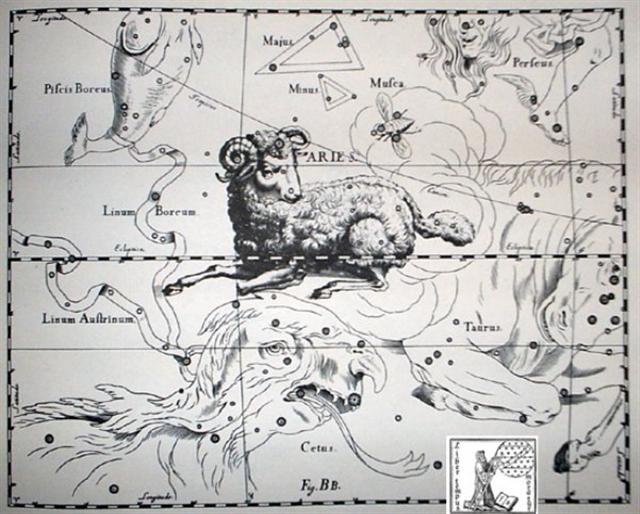
At the time of the Bull the stars
above the head of Cetus had reappeared to visibility
around 64 + 16 = 80
right ascension days earlier than at the epoch of
rongorongo, and this phenomenon
might have been thought of as a great head pushing
Aries up - in a way similar to how previously the
northern horn on the Head of Taurus had pushed Auriga up:

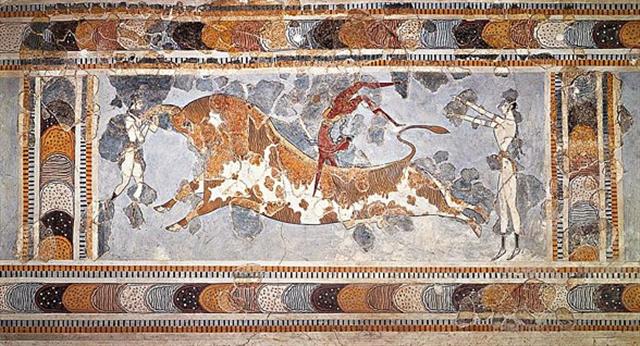
... They were Ranginui, the Sky Father, and Papatuanuku, the Earth Mother, both sealed together in a close embrace. Crushed between the weight of their bodies were their many children, whose oppression deepened. They yearned to be free; they fought their parents and each other to break loose. Tuumatauenga, virile god of war, thrust and shouted; Tangaroa of the oceans whirled and surged; Tawhirirangimaatea, Haumiatiketike and Rongomatane, of wild foods and cultivated crops, tried their best but were not successful; and Ruamoko, god of earthquakes, yet to be born, struggled in the confinement of his mother's womb ... Of them all, Taane Mahuta, the god of the forests, was the most determined; he set his sturdy feet upon his father's chest, and braced his upper back and shoulders against the bosom of his mother. He pushed; and they parted. So the world, as the Maori understand it, came into being ...
| CLOSE TO THE SUN: |
22 |
| Oct 17 (10 * 29) |
18 |
19 |
20 |
21 |
| 'Sept 20 (290 - 27) |
21 (264) |
Equinox |
23 (266 = 366 - 100) |
24 |
 |
 |
 |
 |
 |
| Cb1-1 (393) |
Cb1-2 |
Cb1-3 |
Cb1-4 (396) |
Cb1-5 |
| CLOSE TO THE FULL MOON: |
| April 17 (107 = 80 + 27)
Al Sharatain-1 / Ashvini-1 / Bond-16 (Dog) / Mahrū-sha-rishu-ku-1 (Front of the Head of Ku)
SEGIN = ε Cassiopeia, MESARTHIM = γ Arietis, ψ Phoenicis (27.2), SHERATAN (Pair of Signs) = β Arietis, φ Phoenicis (27.4)
*351.0 = *27.4 - *41.4 |
18
ι Arietis (28.0), λ Arietis (28.2), υ Ceti (28.8) |
19
ALRISHA (The Knot) = α Piscium, χ Phoenicis (29.2), ε Trianguli (29.4), ALAMAK (Caracal) = γ Andromedae (29.7)
*353.0 = *29.4 - *41.4 |
20
Arku-sha-rishu-ku-2 (Back of the Head of Ku)
2h (30.4)
κ Arietis (30.3), HAMAL (Sheep) = α Arietis (30.5)
ALKES (α Crateris)
*354.0 = *30.4 - *41.4 |
21
DELTOTUM = β Trianguli (31.2), ι Trianguli (31.7), η Arietis (31.9)
*355.0
|
| 'March 21 (0h) |
22 |
23 |
24 (83) |
Julian equinox |
| DAY 27 (= 107 - 80) |
28 |
IANUARIUS 29 |
FEBRUARIUS 1 (30) |
31 |
| CLOSE TO THE SUN: |
75 |
| Nov 13 |
14 |
15 |
16 (320) |
| 'Oct 17 (290) |
18 |
19 |
20 |
 |
 |
 |
 |
| Cb2-4 (420 = 740 - 320) |
Cb2-5 (392 + 29) |
Cb2-6 (30 = 108 - 78) |
Cb2-7 |
| CLOSE TO THE FULL MOON: |
| May 14
δ Persei (54.7) |
15 (500 = 365 + 135)
Al Thurayya-27 (Many Little Ones) / Krittikā-3 (Nurses of Kārttikeya) / TAU-ONO (Six Stones)
ATIKS = ο Persei, RANA (Frog) = δ Eridani (55.1), CELAENO (16 Tauri), ELECTRA (17), TAYGETA (19), ν Persei (55.3), MAIA (20), ASTEROPE (21), MEROPE (23) (55.6) |
16 (136)
Hairy Head-18 (Cockerel) / Temennu-3 (Foundation Stone)
ALCYONE (56.1), PLEIONE (28 Tauri), ATLAS (27 Tauri) (56.3) |
17
MENKHIB (Next to the Pleiades = ζ Persei (57.6)
PORRIMA (γ Virginis) |
| 'April 17 (80 + 27) |
18 (108 = 135 - 27) |
19 |
20 |
| BISSEXTUM (54 - 55) |
56 (8 WEEKS) |
57 (= 137 - 64 - 16) |
|
... The leap day was introduced as part of the Julian reform. The day following the Terminalia (February 23) was doubled, forming the 'bis sextum - literally 'double sixth', since February 24 was 'the sixth day before the Kalends of March' using Roman inclusive counting (March 1 was the 'first day'). Although exceptions exist, the first day of the bis sextum (February 24) was usually regarded as the intercalated or 'bissextile' day since the third century. February 29 came to be regarded as the leap day when the Roman system of numbering days was replaced by sequential numbering in the late Middle Ages ... |
At Alcyone - i.e. 27 days after the Knot
(Al-Risha) at the neck of Cetus -
the weather had changed, after the sky roof had been
upraised
and no longer was 'in close embrace' with Mother Earth.
... another Alcyone, daughter of
Pleione, 'Queen of Sailing', by the
oak-hero Atlas, was the mystical
leader of the seven Pleiads. The
heliacal rising of the Pleiads in
May marked the beginning of the
navigational year; their setting
marked its end when (as Pliny
notices in a passage about the
halcyon) a remarkably cold North
wind blows
...
In the pre-Julian Roman calendar
(before 46 BC) Januarius had 29 days, not 31, and at
the end of Januarius was Alrisha (the Knot).
| Martius |
31 |
31 |
- |
| Aprilis |
29 |
30 |
+1 |
| Maius |
31 |
31 |
- |
| Iunius |
29 |
30 |
+1 |
| Quintilis |
31 |
31 |
- |
| Sextilis |
29 |
31 |
+2 |
| Sum |
180 |
184 |
+4 |
| Sept |
29 |
30 |
+1 |
| Oct |
31 |
31 |
- |
| Sum |
240 |
245 |
+5 |
| Nov |
29 |
30 |
+1 |
| Dec |
29 |
31 |
+2 |
| Ianuarius |
29 |
31 |
+2 |
| Februarius |
23 |
28 |
- |
| 5 |
| Sum |
350 + 5 |
365 |
+10 |
... Strassmeier and Epping, in their
Astronomishes aus Babylon,
say that there its stars formed the
third of the twenty-eight ecliptic
constellations, - Arku-sha-rishu-ku,
literally the Back of the Head of
Ku, - which had been established
along that great circle milleniums
before our era; and Lenormant
quotes, as an individual title from
cuneiform inscriptions, Dil-kar, the
Proclaimer of Dawn, that Jensen
reads As-kar, and others
Dil-gan, the Messenger of Light.
George Smith inferred from the
tablets that it might be the Star
of the Flocks; while other
Euphratean names have been Lu-lim,
or Lu-nit, the Ram's Eye; and
Si-mal or Si-mul, the
Horn star, which came down even to
late astrology as the Ram's Horn.
It also was Anuv, and had its
constellation's titles I-ku
and I-ku-u, - by abbreviation
Ku, - the Prince, or the
Leading One, the Ram that led the
heavenly flock, some of íts titles
at a different date being applied to
Capella of Auriga.
Brown associates
it with Aloros, the first of
the ten mythical kings of Akkad
anterior to the Deluge, the duration
of whose reigns proportionately
coincided with the distances apart
of the ten chief ecliptic stars
beginning with Hamal, and he deduces
from this kingly title the Assyrian
Ailuv, and hence the Hebrew
Ayil; the other stars
corresponding to the other mythical
kings being Alcyone, Aldebaran,
Pollux, Regulus, Spica, Antares,
Algenib, Deneb Algedi, and Scheat
...
Possibly the variant of hau tea
with one 'eye' (face, mata) at the back side
(at left, in the past) together with the normal one
in front (at right,
ahead)
illustrated the reversal caused by the top of the head of the
Prince (Ku), at the end of Januarius.

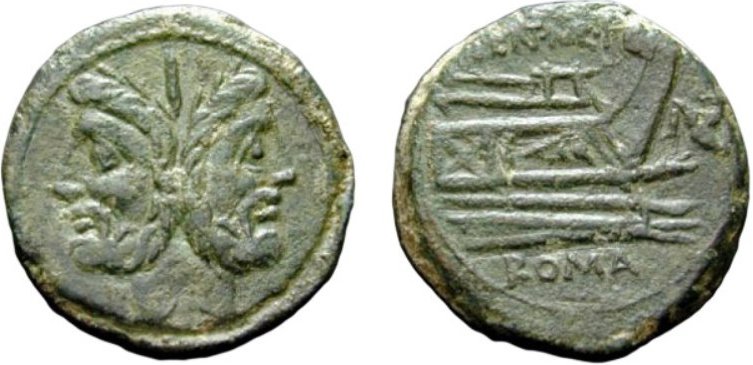
The central vertical line - as if
between the pair of 'Tree legs' of the God of Forests
(Jupiter, Jus Piter, Father Light, the Oak) - could here
correspond to the 'time line' for marking day 136 - 107 = 29
(Mercury):
...
Ganz ähnlich is der Name 'Gott von
Duazag' des Gottes Nabū
... zu erklären.
Er bezeichnet ihn als den Gott des
Wachtstums, welches als aus dem
Osten stammend betrachtet wird, weil
die Sonne, die das Wachstum bringt,
im Osten aufgeht.
Dass
aber Nabū als Ost-Gott
aufgefasst wurde, hängt damit
zusammen, dass sein Stern, der
Mercur, nur im Osten oder Westen
sichtbar ist ...
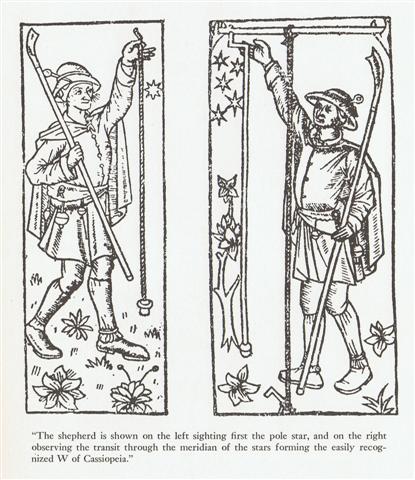
|
CLOSE TO THE
SUN: |
|
Jan 31 |
Febr 1 (32) |
2 |
3 |
4 (*320) |
350 - 29 = *321 |
|
'Jan 4 |
5 (370 = 740 /
2) |
6 |
7 |
8 |
9 |
 |
 |
 |
 |
 |
 |
|
Cb5-13 (107) |
Cb5-14 (392 +
108) |
Cb5-15 (365 +
136) |
Cb5-16 |
Cb5-17 (503) |
Cb5-18 (584 -
80) |
|
μ Aquarii
(316.0) |
ε Equulei
(317.8) |
no star listed
(318) |
21h (319.6)
ARMUS =
η
Capricorni(319.0),
DORSUM =
θ
Capricorni (319.3),
TSOO = 24
Capricorni
(319.7) |
DRAMASA = σ
Oct.,
χ Capricorni
(320.0), ν
Aquarii (320.3),
γ Equulei
(320.6), ο
Pavonis (320.8) |
α
Oct. (321.5),
δ
Equulei (321.7),
φ
Capricorni
(321.8) |
 |
|
CLOSE TO THE
FULL MOON: |
|
Aug 1
γ Pyxidis
(133.6) |
2 (214 = 32 +
182)
ζ
Hydrae (134.1),
ρ
Cancri (134.2),
ζ
Oct.
(134.3), ο
Cancri (134.6),
δ Pyxidis
(134.9) |
3
ACUBENS = α
Cancri,
TALITHA BOREALIS
= ι Ursae
Majoris
(135.0), σ
Cancri (135.2),
ρ Ursa Majoris
(135.6) |
4
ν Cancri
(136.0),
TALITHA
AUSTRALIS = κ
Ursae Majoris
(136.1), ω
Hydrae (136.8) |
5
9h (137.0)
σ¹ Ursa Majoris
(137.0), κ
Cancri (137.3),
τ Cancri
(137.4),
ALSUHAIL (al
Wazn, of the
Weight) = λ
Velorum
(137.5), σ² Ursa
Majoris (137.6),
τ Ursa Majoris
(137.7), ξ
Cancri (137.8)
*96.0 = *137.4 -
*41.4 |
6 (584 → Venus)
κ Pyxidis
(138.0), ε
Pyxidis (138.5) |
|
'July 5 |
6 (*107) |
7 |
8 |
9 (190) |
10 |
|
DAY
133 |
134 |
135 |
136 = 29 + 107 |
137 |
138 |
360 + 4 = 364 (= 354 + 10), and 26 (Polaris) + 4 =
30 (Hamal), and Dramasa (320) + 4 = 324 (= 314 +
10).
|
 |
9 |

|
108 |
|
April 10 (100) |
April 20 |
|
KSORA (Knee) |
HAMAL |

| CLOSE TO THE SUN: |
| Febr 6 (37) |
7 (403) |
8 (*324) |
| 'Jan 10 (*295) |
11 |
12 (377) |
 |
 |
 |
| Cb5-19 (505 = 392 + 113) |
Cb5-20 |
Cb5-21 (115 → Mercury) |
| KITALPHA (Part of a Horse) = α Equulei (322.0), ALDERAMIN (The Right Arm) = α Cephei (322.9) |
DAI = ι Capricorni (323.5), β Equulei (323.8) |
γ Pavonis (324.1), YAN = ζ Capricorni (324.6) |
|
CLOSE TO THE
FULL MOON: |
| Aug 7 |
8 (220) |
9 |
| π Cancri (139.2), MIAPLACIDUS = β Carinae (139.3), TUREIS (Little Shield) = ι Carinae (139.8) |
no star listed (140) |
θ Pyxidis (141.5), MARKAB VELORUM = κ Velorum (141.5), AL MINHAR AL ASAD (The Nose of the Lion) = κ Leonis (141.6), λ Pyxidis (141.9) |
| 'July 11 |
12 (193) |
13 (560) |
| DAY 139 |
140 |
141 |
| CLOSE TO THE SUN: |
| Febr 9 (*325 → equinox) |
10 |
11 (42) |
12 (408 = 3 * 136) |
| 'Jan 13 (378 → Saturn) |
14 |
15 |
16 |
 |
 |
 |
 |
| Cb6-1 (508 = 2 * 254) |
Cb6-2 |
Cb6-3 (118 = 4 * 29½) |
Cb6-4 |
|
CLOSE TO THE
FULL MOON: |
| Aug 10 Star-25 (Horse) / ANA-HEU-HEU-PO-5 (Pillar where debates were held)
ALPHARD (The Horse) = α Hydrae (142.3), ω Leonis (142.6), τ¹ Hydrae (142.7) |
11 Al Tarf-7 (The End)
ψ Velorum (143.3), ALTERF = λ Leonis, τ² Hydrae (143.4), ξ Leonis (143.5)*102.0 = *143.4 - *41.4 = *286 - *184 |
12 A Hydrae (144.1)
VEGA (α Lyrae) |
13 (225 = 15 * 15) UKDAH (Knot) = ι Hydrae (145.4), κ Hydrae (145.5), SUBRA = ο Leonis (145.8)
*104.0 = *145.4 - *41.4 = *288 - *184 |
| 'July 14 |
15 (196) |
16 |
17 (564) |
| DAY 142 |
143 |
144 (= 12 * 12) |
145 (= 290 / 2) |
... On February 9 the Chorti Ah K'in, 'diviners', begin the agricultural year. Both the 260-day cycle and the solar year are used in setting dates for religious and agricultural ceremonies, especially when those rituals fall at the same time in both calendars. The ceremony begins when the diviners go to a sacred spring where they choose five stones with the proper shape and color. These stones will mark the five positions of the sacred cosmogram created by the ritual. When the stones are brought back to the ceremonial house, two diviners start the ritual by placing the stones on a table in a careful pattern that reproduces the schematic of the universe. At the same time, helpers under the table replace last year's diagram with the new one. They believe that by placing the cosmic diagram under the base of God at the center of the world they demonstrate that God dominates the universe. The priests place the stones in a very particular order. First the stone that corresponds to the sun in the eastern, sunrise position of summer solstice is set down; then the stone corresponding to the western, sunset position of the same solstice. This is followed by stones representing the western, sunset position of the winter solstice, then its eastern, sunrise position. Together these four stones form a square. They sit at the four corners of the square just as we saw in the Creation story from the Classic period and in the Popol Vuh. Finally, the center stone is placed to form the ancient five-point sign modern researchers called the quincunx ...
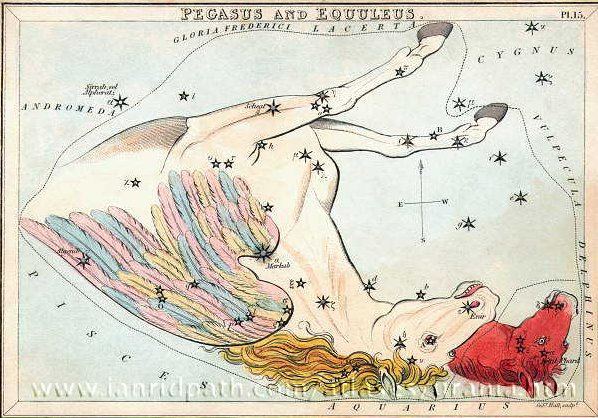
|
























